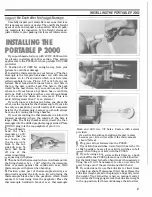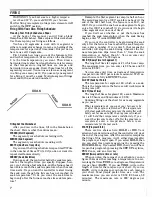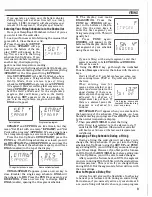
TERMS
&
FEA TiJRES
Summary of Keys
FUNC
brings the Func
tion Switches into display.
This key works only when a
Set-Up Mode is displayed.
DISP
takes you out of the
Set-Up displays and into the
firing temperature displays.
Also takes you through the
firing messages in the bottom
of the display.
RESET
is used in a
Func
tion Switch display. It will
cancel a new adjustment.
This is useful
if
you make a
mistake with the arrow keys.
SET
UP
brings the Set
Up Modes into display.
turns a
firin
g
schedlile on or puts it
on hold. NOTE: This key
does not turn the furnace off.
AUTO
TUNE
runs a test pro
gram on the controller that adjusts
the controller
1<)
run at its best on
your particular
furnace.
Arrow Keys
change
temperature, time, and turn
features on and off.
If you would rather remove the kiln sitter entirely,
conslilt a kiln technician.
1 O.
For automatic venting, drill a 112" hole in the center
of the kiln lid (on top loading kilns) and leave peephole
plugs out. (The only peephole plug left in place will be
the drilled thermocouple plug.) On front loading kilns,
leave peephole plugs out or peephole covers open. Some
firings may require additional venting through the lid
prop of top-loading kilns.
TERMS & FEATURES
of Terms
Display Messages, Operation and Set-up
There are
two types of messages in the display window: operation
and set-up. During firing, the display window gives you
information on fi..�g progress. TheBe are operation
messages. When you make adjustments on the control
ler, the display window shows you which adjustment
you are making. These are the set-up messages.
12-Segment Program
The SPPROG program, one of
three methods to fire your furnace. This is the heart of
your controller. The 12-segment program is a set of
instructions your controller uses to control firing speed,
temperature, soaking time, etc. It has six ramps and six
soaks. You can use a factory pre-set 12-segment pro
gram, or you can enter your own 12-segment program
into the controller. We will show you how.
Function Message
All
the adjustments made on the
controller are organized under 8 Set-Up Modes. You
must have the oorrect Set-Up Mode displayed on the
screen before making an adjustment. Then you must
press the
FUNC
key until the adjustment you
are
making appears in the display window. This adjustment
display is called a Function Message.
3
Normal Temperature Display
Furnace temperature.
When you are running a SPPROG or SPRAMP program,
the controller display window shows the firing display.
When you are not running a program, the window shows
the normal temperature display. The controller shows
normal temperature display when you first plug it in. In
normal temperature display, the bottom display is
blank.
Ramp
A
ramp is a stage of programnied firing where
the temperature is either raised or lowered.
Time
is the
only thing you can adjust in each ramp.
Segment
The controller fires your furnace or kiln in
stages.
A
stage is called a segment. There are two types
of segments: ramps and soaks.
Set Point
This is the temperature the furnace is either
trying to reach or is soaking at. There is always a set
point, whether you are firing a program or not.
An
example: if you set the thermostat in your home to
70·,
70·
wolild be the set point for the thermostat.
If
you just want to
fIre
to temperature without caring
about firing speed or shut-off, you can Single Set Point
fire without a program. (See Single Set Point.)
Set-Up Mode
The controller has eight different adjust
ing modes. To make an adjustment, you must be in the
correct adjusting mode, or Set-Up Mode. When you
press the
SET
UP
key, the controller will enter a Set-Up
Mode. This works the same way as the mode button on
a digital wrist-watch.
Single Set Point
The controller -is never idle. It is
always working. It's like the thermostat in your home.
It
is always trying to maintain a certain temperature
inside your furnace. When you are not firing a program,
the controller is still set for a temperature, which is
called the Single Set Point. After you run a SPPROG or
SPRAMP program, the last temperature of the program
becomes the Single Set Point.












